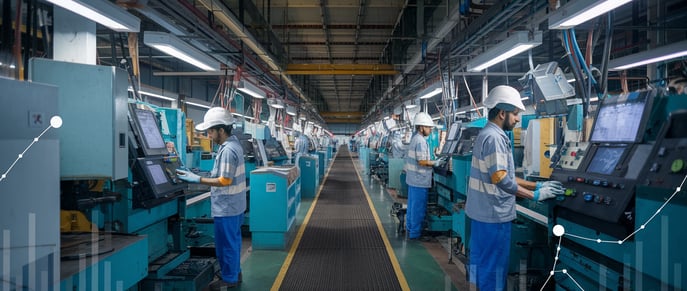India's Manufacturing Growth Hits 12-Month Low in December
India's manufacturing sector growth slowed to a 12-month low in December, with the PMI dropping to 57.5. This blog explores the factors behind the deceleration, including sluggish demand, rising costs, and global economic challenges, while highlighting opportunities and strategies for long-term resilience in the sector.
beingMJ
1/2/20252 min read


As the year came to a close, India’s manufacturing sector faced a slowdown, with growth hitting a 12-month low in December. According to the latest data released from industry reports, the Manufacturing Purchasing Managers' Index (PMI) dropped to 57.5 in December from 58.5 in November. While the PMI figure above 50 still indicates expansion, the deceleration has raised concerns about the sector's resilience amid domestic and global challenges.
Understanding the PMI Decline
The PMI is a key economic indicator that reflects the health of the manufacturing sector. A reading above 50 signifies expansion, while a reading below 50 indicates contraction. December's dip to 57.5 marks the lowest level since December 2022, indicating that the pace of growth has slowed significantly, even though the sector remains in expansionary territory.
Several factors contributed to this slowdown:
Sluggish Demand: While demand remained strong overall, there were signs of moderation, especially in export orders. Global economic uncertainties, fueled by geopolitical tensions and inflationary pressures, have dampened external demand for Indian goods.
Rising Costs: Input cost inflation, driven by elevated commodity prices and supply chain disruptions, has put pressure on manufacturers. Although some companies have been able to pass on higher costs to consumers, others are grappling with squeezed profit margins.
Monetary Policy Impact: The Reserve Bank of India (RBI)’s tightening monetary policy over the past year has increased borrowing costs. Higher interest rates may have dampened investment and consumer spending, indirectly impacting manufacturing output.
Global Slowdown: A weakening global economy has reduced demand for Indian exports. Key trading partners, including Europe and the United States, are facing their own economic challenges, which have trickled down to India’s manufacturing sector.
Bright Spots Amid Challenges
Despite the slowdown, there are reasons for cautious optimism. Certain sectors, such as pharmaceuticals, electronics, and renewable energy components, continue to perform well, buoyed by both domestic demand and government initiatives.
The government’s Production Linked Incentive (PLI) schemes have provided a boost to sectors like electronics manufacturing, textiles, and automotive components. Additionally, efforts to attract foreign investment and strengthen local supply chains are expected to bolster the sector in the medium to long term.
Outlook for 2024
Experts believe that while the manufacturing sector may face short-term headwinds, the long-term outlook remains positive. India’s large domestic market, ongoing infrastructure development, and strategic focus on becoming a global manufacturing hub are expected to drive sustained growth.
However, addressing immediate challenges will require a multi-pronged approach. Policymakers and industry leaders will need to focus on:
Mitigating supply chain disruptions
Containing inflationary pressures
Expanding export markets through trade agreements and diplomacy
Encouraging technological adoption and innovation in manufacturing processes
Conclusion
The 12-month low in India’s manufacturing growth serves as a reminder of the sector’s vulnerabilities to both domestic and global factors. As we step into 2024, a balanced approach that addresses immediate challenges while building long-term resilience will be key to sustaining the sector’s growth trajectory. With the right policies and industry collaboration, India’s manufacturing sector has the potential to regain momentum and continue driving the country’s economic growth.
Contact Us :
beingaimj@gmail.com
© 2024. All rights reserved.
